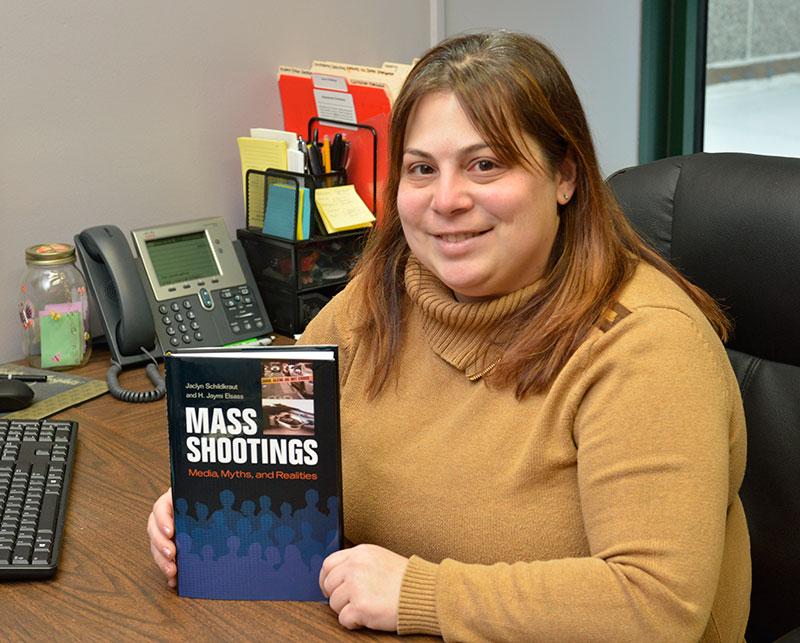Debunking myths—SUNY Oswego public justice faculty member Jaclyn Schildkraut displays a new book, co-authored with research partner H. Jaymi Elsass of Texas State University, that marshals years of research to counter what they call “media myths” about the prevalence and frequency of mass shootings in the United States and aims to place them into historical, statistical and political context.
Through years of research and consolidating lessons learned from rampages in schools, movie theaters and malls, Jaclyn Schildkraut of SUNY Oswego’s public justice faculty has co-authored a book that probes myths and hysteria provoked by mass shootings.
“Mass Shootings: Media, Myths, and Realities,” by Schildkraut and research partner H. Jaymi Elsass of Texas State University, is a newly published entry in Praeger’s Crime, Media and Popular Culture Series. It sets out to put into context the statements often heard and read in the media about the prevalence and frequency of these deadly attacks in the United States.
“By writing this book, Professors Schildkraut and Elsass have provided a great service to educators, researchers, journalists, other concerned professionals, and interested laypersons who are trying to understand mass shootings,” wrote reviewer Ralph W. Larkin of John Jay College of Criminal Justice at the City University of New York. “They provide historical and international contexts to debunk popular notions and have created a clearer picture of the nature and etiology of rampage shootings.”
The book evolved from Schildkraut’s doctoral dissertation, “Mass Murder and the Mass Media: An Examination of the Media Discourse on U.S. Rampage Shootings, 2000-2012,” at Texas State. Subsequent peer-reviewed articles and the book—her and Elsass’ first-of-its-kind effort to define, rigorously research and give national and international context to the horrific events that create what they call “media spectacles”—attracted national attention from sources such as the Wall Street Journal, National Public Radio, The Economist, FactCheck.org and even Popular Science.
‘Required reading’
Reviewers of the new book think the attention is deserved. For instance, Glenn W. Muschert, a sociology faculty member at Miami University in Ohio, wrote, “This book is required reading for anyone interested in understanding mass killing events. With a clear voice and insightful analysis, the authors break significant ground in the study of mass shootings, ultimately bringing the history, development, discussion, and prevention of such events into sharp focus.”
Schildkraut said that despite the fact she has personally become an advocate on behalf of mass shooting victims, the book’s matter-of-fact voice is intentional.
“What we try to do is let the information speak for itself and stand on its own. We try to paint a very clear picture using examples and talking about how this phenomenon is really affecting our society now and how we can better understand it in the future,” she said.
It is important, she said, that parents, law enforcement officials, lawmakers—and especially the media—work from sets of facts and not hasty reactions to wall-to-wall coverage of such mass tragedies as those in Columbine and Sandy Hook.
“I get it—you’re trying to get news on television first, and if you’re there first you get ratings, and ratings equal advertising dollars,” Schildkraut said. “But there’s a much larger consequence to doing that, because media are so ingrained—that’s where most people get their news—it’s like wielding a gun or any type of weapon very carelessly.”
The book showcases specific examples of inaccurate, misleading and fabricated news reports, such as the stories and subsequent social media posts that portrayed the brother of the Sandy Hook killer as the prime suspect for five hours before media reversed course based on information from identified official sources.
“We think the book will appeal to students on campus, journalists, to a person in everyday life, and it could actually appeal to policymakers, because you can’t fix a problem when you don’t understand what the problem is,” Schildkraut said.
“The loss of one life in these events is absolutely one too many. But you cannot create policy and security practices based on hysteria,” she said. “That’s what is happening. I think the fact that some sources have been willing to listen to a different narrative or listen to a different approach has been very beneficial and makes us work toward getting a larger audience to listen to that perspective.”




